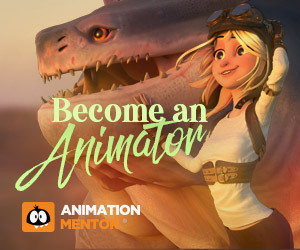Matt Shepherd
Interview conducted by Eric Scheur
The audio clip for March's competition was taken from the 1967 classic, In the Heat of the Night starring Sidney Poitier and Rod Steiger. And without trying to turn this into too much of a movie column, I want to tell you that you have to see this movie. If you are interested in seeing some of the most compelling and original acting choices you're likely to come across, Rod Steiger is nothing short of spectacular here. His performance won him the Best Actor award, and it's not hard to see why. Even the intensity he provides in the clip that 119 11 Second Club entrants animated to draws you in so completely that you feel like you're right there with the character breathing down your neck.
Taking full advantage of that intensity, Matt Shepherd crafted a scene where we feel a sense imminent danger with an aging detective and his tagalong on a burglary case. Everything in the piece, from the facial expressions to the hand gestures, from the set design to the color choices, tells the viewer everything they need to know in order to get the sense of where we are in the story. This kind of full realization is what takes an animator to the top spot in our monthly competition.
Congratulations to Matt and everyone who accepted the challenge of animating March's heavy-breathing, threatening audio clip. Read further for some insight into Matt's background and his approach to creating his winning entry.
- Eric
How did you get into animation?
Much like most or all animators and artists, I began drawing at a young age. All through school I drew comic strips. Growing up I always told people I wanted to work for Disney, or draw comic strips for the paper.
I attended the Animation and Graphics Technology course at New Brunswick Community College//Miramichi in Canada; it was either there or Sheridan. The course had some great instructors while I was there and it still does. While at NBCC I learned the basics, animation principles, layout and design, life drawing, story telling, story boarding, animation history, some acting, the list goes on. Oh and of course, we learned to animate on paper, with a blue pencil and a good ol’ fashioned animation disc. Good times.
Your still drawings and characters have a great personal style to them. Who are some of your influences?
I have become a big fan of Rune Bennicke, I really like how he keeps everything loose and cartoony with his personal work and yet remain feature quality, its great to watch. Also John Kricfalusi, his wonky style and edgy content is fantastic. When I work I like to keep things loose, it borders on off model though. I realize my construction needs more work but honestly, I’d rather just try and animate like Rune and implement John K’s wonky drawings and comedic timing. Again, I stress, try.
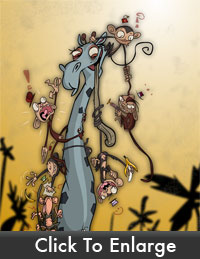
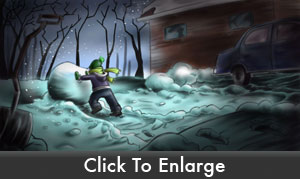
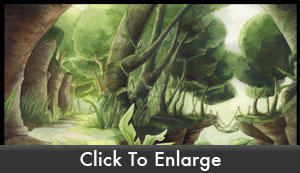
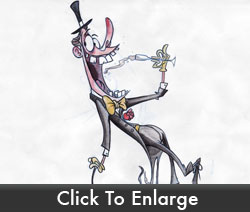
(for more of Matt's artwork, visit his blog at : cartooncontent.blogspot.com)
You also have some great life drawing on your site. In your own words, can you describe the relationship between life drawing and drawing more stylized characters?
Life drawing is very important. I don’t know anyone in animation who would say otherwise. In my opinion it’s the foundation to good animation, even if it’s exaggerated or seems to be off model.
Talk about one or two scenes from an animated movie or television show that you can watch over and over and never feel the entertainment level drop.
Oh wow, I don’t know. There are a lot of scenes that I would like to pick but my choice would have to be Rune Bennicke’s animation reel from the Tigger Movie. Man, that stuff is tremendous. That clip has excellent timing and a lot of appeal.
Talk about your animation process.
During the planning stage, I try and decide upon a certain style or color, or at least have an idea before I start animating, so that I can cut corners if I have to.
When I start, I listen to the audio a few times and try and visualize what would be interesting to see happen. Then I’ll rough in some loose shapes when I am planning out the timing. From there I’ll just try and settle on a loose design within the first week, usually 3/4, the rest works itself out when I am figuring out timing and posing.. I drew this guy for this specific audio clip. Sometimes you just start roughing in some shapes and it just so happens you drew a fat guy or skinny guy. I usually just run with that, first instinct, not the best method but for all intents and purposes I’m not going to be fussy.
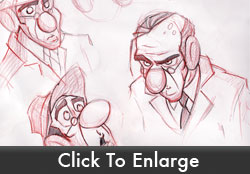
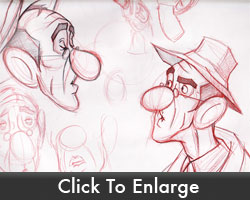
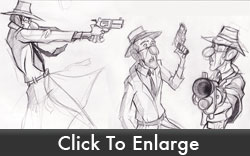
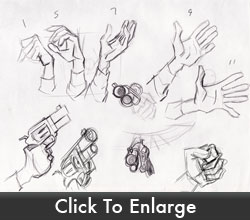
Based off of the initial timing and rough staging, I sketch in a background, I form my background around the character, keeping it rough. After I finish the animation and start to settle on a final background I start to play with a color palette. At this point I usually adjust the staging and composition if needed.
How did you create the backstory for this piece?
When I listened to the audio clip, it felt like the voice was coming from an older detective type, so then I was thinking, what would make sense? What if they are investigating a break-in at some shady house out in the woods? So they approached the house, see the broken window and that’s when we tune in. From there I decided I wanted the animation to resemble 101 Dalmatians, so what you saw was my attempt at that.
I love how much you milk the pose of your detective/investigator character. He pretty much stays in one pose for the entire piece, and yet he never feels boring or lifeless.
It’s obvious from the audio that this guy isn’t yelling or raising his voice much. I interpreted that like most of the entries by trying to keep it subtle. For me that meant he wasn’t going to be flailing all over the place like a maniac, although I think that would have been funny. I just tried to keep it appealing with subtle head movements and animating him into an interesting pose, or at least a pose that didn’t look awkward.
I love the gesture with the gun on "in my life." Where did that come from?
Sword in the Stone, I always liked how animated the hands were with Merlin and Madam Mim, very inspiring. What you saw was my attempt at something around those lines.
Do you ever show your work in progress to friends or the 11 Second Club Forum?
Definitely, I like to show certain people before I send my work off to the world wide web. For the March animation, a friend pointed out that I was framing the shot a bit tight, so I adjusted the camera move and the match cut to allow for some more breathing room.
Did you find yourself struggling with any part of the animation?
Of course, I found animating the gun very awkward. If you watch the critique, Jason points out that the gun is getting a bit paper cut out, so clearly my approach was a quick fix and not permanent fix. But as far as figuring out the gun and how to draw it, I had a reference picture pinned in my scene, it helped shed some light on how this object would look.
Did the eCritique enhance any of the ideas you had originally set out to animate?
The anticipation leading into the camera move, very neat, I had never really thought of that before. I guess working in television animation for so long really blinds you to some aspects of the art. 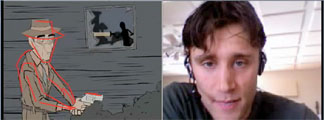
Another part was moving the jaw. I learned that in college but sort of forgot about it. The idea of that wasn’t new but the method in which he was suggesting to use it was helpful. Also, Jason suggested having some subtle movement on his hands when he moved to help make the gun look less like a paper cutout. That was another helpful and great suggestion.
Do you intend to return to this piece to incorporate the suggestions made in the eCritique?
Absolutely. It was a great experience to have someone like Jason take the time to review my animation and point out what he thought I could improve on and what would make the scene better, I really appreciated it and I will definitely remember what he said next time I start an animation.
What advice would you offer to someone who was just starting their animation education? Any particular exercises or secret tips that have helped you along the way?
My advice would be to decide what you want out of animation before going into it; do you want to work on television or features? Then tailor your portfolio/demo and take the steps necessary to achieving your goals (learn 3D or 2D or both, practice animation, draw alot, animate in your spare time, etc.).
All in all, I think the best advice would be practice and observe: practice animating and observe life. I suppose that’s nothing new for people to read but it’s easy to fall into a slump and not take the steps towards improving one’s artistic skills. It’s like a jump shot in basketball, you can want to be better at it all you want and watch someone taking a jump shot but the only way to get better at it is by practicing. Feel free to laugh, but it’s true!
- Matt Shepherd
Discuss this interview in the forums
comments powered by Disqus






